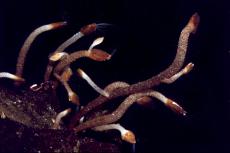Hydrothermal vents
Hydrothermal vents are places in the Earth’s crust where very hot water arises from vents in the cold, deep-sea floor. This hot, mineral-laden water is a rich environment for the development of an exotic marine life, previously unknown before the discovery of hydrothermal vents. This marine life uses a quite different chemistry from other animal life, be it marine life in the upper sea levels, or terrestrial life. Thus, hydrothermal vents are not only very interesting geologically speaking, but even more so from the biological point of view.
Their discovery
Prior to the 1970s, hydrothermal vents were an unknown phenomenon, but certain observations had led marine geologists to hypothesize that vents existed. Rocks had previously been recovered from the sea floor containing minerals known to form when volcanic rocks react with seawater. Such rocks are to be seen on Iceland and other volcanic islands today. And sediments with unusually high amounts of iron, manganese, and other metals are found near mid-ocean ridges. There are also large chunks of ocean crust, kilometers thick, known as ophiolites, that have been lifted up onto land by tectonic forces. These ophiolites show evidence of hot seawater circulation through fissures in the rocks in the distant past.
Furthermore, heat flow anomalies indicated that the crust near a mid-ocean ridge crest was cooler than expected. It was infered that the crust was cooled by circulation of seawater through cracks and fissures in the rock. There were also deep-tow temperature anomalies. An instrument package towed at about 2500 meters depth near the East Pacific Rise, a geologically active zone betwen the Pacific tectonic plate and the Nazca plate, measured an average temperature of ca 2°C, but detected warmer water temperature peaks of 0.1°C to 0.2°C.
This then led geologists, in 1977, to organize an expedition to an area of the East Pacific rise near the Galapagos islands, some 2500 meters below the surface. They took a deep tow instrument and Cousteau’s research submersible Cyana. They first found slightly warm water with the deep tow, then dived on that spot in Alvin. As they hoped, they found 20°C warm water seeping from fissures. But more importantly, they found a strange alien landscape littered with what looked like chimneys expelling clouds of black smoke.
The greatest surprise, however, was that there were very numerous, large animals living around the vents. Surrounding these chimneys was a unique type of ecosystem that had never been seen before. These animals turned out to be completely new species, often new Families or Orders, and even one new Phylum. Until then, it had always been assumed that all life on Earth obtained its energy from the sun. Using a process called photosynthesis sunlight is converted into energy by plants which, in turn, provide food for countless species of animals in a complex web of life. But here was a sight that challenged those assumptions. Here was proof for the first time that life could be sustained by the earth itself, totally cut off from the world of sunlight.
Hydrothermal vents and their formation
Hydrothermal vents occur in geologically active regions of the ocean floor where the planet’s crustal tectonic plates are slowly spreading apart thus allowing magma to well up from below to form mountain ranges known as mid-ocean ridges. Vents are usually clustered in fields and normally found at a depth of more than a kilometer. Most have been discovered along the crest of the Mid-Oceanic Ridge, a 74000 kilometer-long chain of mountains that wraps around Earth like the seam on a tennis ball. A few vents have also been found at seamounts, underwater volcanoes that are not located at the intersection of the tectonic crustal plates.
As cracks form in the ocean floor at these spreading centers, seawater seeps a kilometer or two down into the hot rock where it is heated by the intense heat of the magma. As the water is heated to boiling point, it expands and rises back to the surface, up through the cracks and fissures through which it dropped. On its way back up, the hot water dissolves minerals and other chemicals from the rock. When it reaches the ocean floor, the water is a rich, chemical soup. Some of the minerals precipitate out of the sea water and harden on the rim of the vent. Over time, the rim of the vent is built up into a tall, chimney-like structure. These chimneys are formed from dissolved metals that precipitate out when the super-hot vent water meets the surrounding cold deep ocean water. Individual vent openings typically range from less than a centimeter to more than two meters in diameter.
Vent chimneys can grow very rapidly, up to 9 meters in 18 months. During a December 1993 dive to the Phoenix vent field, Alvin accidentally toppled a 10 ...
Download the full article ⬇︎

Originally published
X-Ray Mag #5
The other side of Cayman Islands - Sister Islands - Bloody Bay Wall - Coral Spawning - free diving world record. Cave diving in Siberia. Philippines: Cabilao. Norway: the wrecks at Narvik - one of the biggest naval battlegrounds of WW2. Finding the U-89 off Ireland. Visiting Fourth Element Interviewing Cathy Church, photographer extraordinaire. Sam MacDonald marine metal sculptures. Ecology: tagging whale sharks. Photography: Going digital. Science: Hydrothermal vents





































